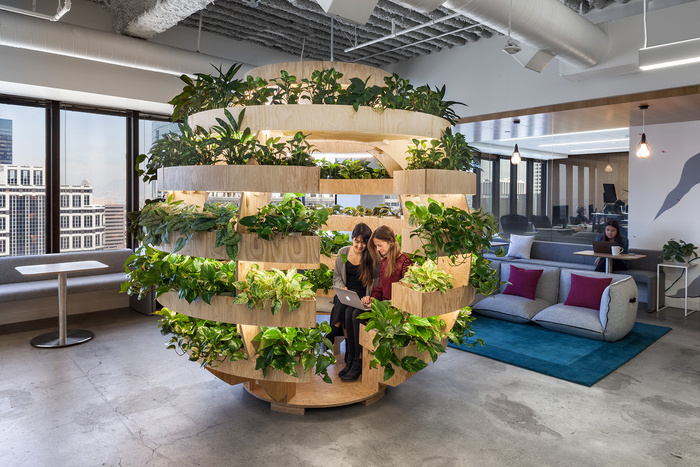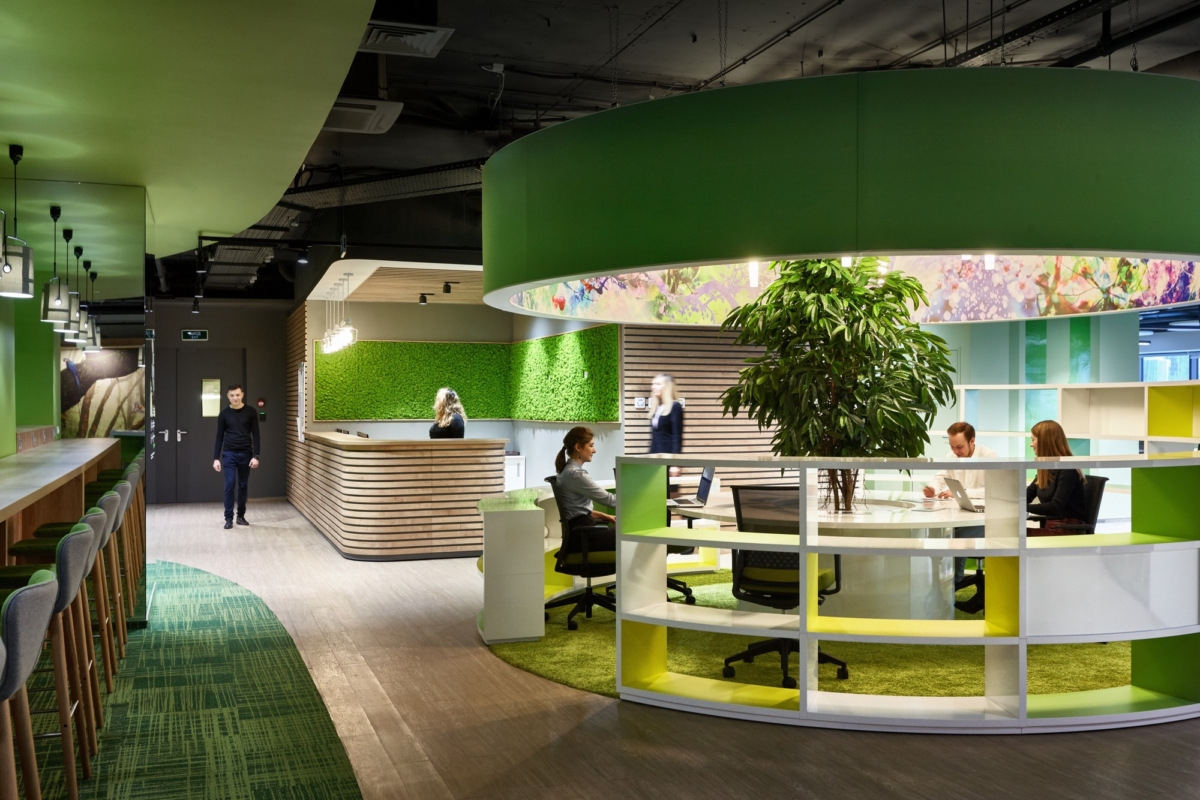The pandemic has come to question everything we knew so far on modern workplaces. Employers and employees, designers and architects, HR specialists and health advisors, they have all sat around virtual tables all over the world to discuss and debate on what the future holds. The pre-COVID popular term ”modern workplace” has been widely replaced by the new and catchy ”future workplace”. Ergonomics, efficiency, hygiene, easthetics- everything needed to be seen from a different perspective. From creating the ideal home office to boost productivity and inspiration in these days of social solitude to transforming open space offices into safe and welcoming environments for employees to come back to. So, what comes next? Moving from theory to practice, apparently now is the time to utilize and optimize this huge pile of unexpected information we’ve gathered so far and move forward into the post-Covid era. In other words, now is the time to separate promising innovations from opportunistic trends and act on it.
So, let’s get down to business and discuss the concept of outside offices, one of the most intriguing, outside the box ideas that have attracted the attention of nearly anyone who is even slightly interested in how work spaces will be shaped in the days to come. A controversial blend of futuristic elements and going back to basics at the same time, with the right dose of ”how can we make this actually work in the long-term?”. And not to be confused, by outside office we refer to a company’s investment in creating a specific outside area to be used exclusively as an outside office by the employees, not a shared co-working space and definitely not a private home office in the back yard. Even though this last one sounds kind of dreamy to be honest.
Working al Fresco
There is fresh air, the most valuable free good, and then there is the air that tries its best to mimic fresh air. Obviously, original fresh air with all its benefits for mind, body and soul can only be found outdoors and in the most cost-efficient way, the cost-free way. When it comes to the indoors, it’s the ventilation system’s resonsibility to bring air quality as close as possible to the quality of fresh air. Good ventilation has always been important for companies – except maybe from when it was considered totally normal to smoke inside and meetings were surrounded by a foggy cloud – but it is only now that a strong ventilation system is considered key strategy to secure and promote longevity.
But what if you could partially reallocate the cost of incorporating an excellent ventilation system to creating a highly functional outside office? Could this re-direction of such a large-scale investment surve the same purpose, a purpose no other than ensuring the best possible air quality for your employees? The only way to investigate the potential of such a big decision is to set aside any cost-related information and focus on human-related factors. The question to be answered here is whether the installation of outside offices can potentially benefit the overall health, wellbeing and, consequently, the performance of the employees to a measurable extent that wil balance out and even exceed the initial cost of the investment.
Putting the cost of installing the most advanced ventilation system and the cost of building an outside office from scratch on the same scale might sound a bit of a strech and that is absolutely reasonable. But incorporating an outside office in the current working area doesn’t necessarily mean creating a garden-like oasis out of nothing. Outside offices can be part of the initial design in the form of unused or neglected balconies or terraces. In fact, a rennovation or a remodelling can work equally well in certain cases, if not better.


COOKFOX studios in New York. An environmentally responsible architecture firm founded in 2003 with the core mission to re-evaluate how people interact with buildings and nature. On the left we see the studio’s east terrace with planting beds for vegetable and herbs and on the right we see its west terrace that is designed for working in nature with both an outdoor conference room and large and individuals worktables. Photography by Eric Laignel.
The value of excellent air quality is not to be underestimated. There are studies showing a risk of almost 20 times higher for COVID-19 to be transmitted inside while, at the same time, indoor pollutants such as mold, dust, smoke and all kinds of building, cleaning and painting chemicals can make indoor pollution up to five times worse compared to outdoor pollution, according to the U.S Environmental Protection Agency.
Less Crowded Offices
By now, it is widely accepted that home office regulations will change drastically in the post-COVID era. Everything is on the table now that companies have finally been given the opportunity to see in practice the pros and cons of allowing their employees to work remotely for long periods of times, an experiment that many companies were not ready to explore before. It is more than a safe assumption to make that employees will be offered flexible work contracts from fully working remotely to various combinations of working both from home and on site. The most obvious outcome of such a turnaround will be the less number of people being at the office at any given time. Now imagine adding an extra outside workspace to this equation. Needless to say that this will end up into a further reduction of the total number of employees working inside. And speaking the newly found pandemic language this definitely translates into much safer and healthier working environments.



On the left we see the LinkedIn Design Lab Rolling Conference Prototype, the company’s first step towards testing outdoor workspaces in early ’19 (photo by Emily Hagopian). This first effort was soon extended to what we see on the right, an experimental outdoor workspace in Sunnyvale, CA, a 17 foot-long central, shared worktable with permanent no-glare monitors, adjustable height chairs and retractable overhead shades (photo by Tony Chung).
From Bringing the Outside in to bringing the Inside Out
Already a rising trend way before the pandemic, biophilic design is the concept of incorporating aspects of nature including natural lighting, natural landscape features and dozens of plants of all colours and sizes into the working environment aiming to boost productivity, creativity and concentration of the workforce. Quite popular among architects and designers, biophilic design originates from the word ”Biophilia” that was introduced by the psychoanalyst Erich Fromm in his book The Anatomy of Human Destructiveness (1973) and was described as the ”passionate love of life and of all that is alive”. The term was soon widely embraced by scientists and philosophers leading to the famous ”Biophilia hypothesis” presented by Edward O. Wilson in his book Biophilia (1984), a hypothesis that recognized the human need to connect with nature not only as a physiological need as Fromm suggested but as a genetic need as well.


Interesting interpretations of Biophilic Design from all around the globe; from health insurance service concierge JOANY in Los Angeles on the left to financial services company Sberbank in Moscow on the right. Photos originally published in Office snapshots.
There are several scientific findings in favor of the above statement. One great example is the link between exposure to natural light and improvement of the overall physical and mental health and productivity through natural light’s superpower to regulate the circadian rythms. Likewise, strong evidence suggest that strengthening the connection between employees and nature can lead to healthier workplace exposure, mainly through reducing work-related stress – a major work hazard nowadays.
Building more sustainable, close to nature workspaces with plenty of natural light and natural materials, such as wood, that among all other health-related benefits they also alleviate climate change is a brilliant new-age movement, as opposed to the traditional artificial lighting and the much more carbon dioxide emitting steel and concrete. So, why don’t we further elaborate on this refreshing new thinking and change the narrative just a little bit? If nature is the key, it is worth exploring a shift from bringing nature to the office to bringing the office back to nature. This is to say, if we anyway go through all this trouble to make indoors look and feel like outdoors we may as well try outdoors to begin with.
A Matter of Comfort and Control
There is one major issue rising the moment we start thinking about investing in an outside office. How can we control the weather conditions? The wind affects the acoustics, the sun affects the screens and let’s not even start on the climate. What if your company happens to be located in a too cold or too hot country?
Control over the working conditions is the most obvious advantage of the traditional workplace. Temperature and light can and will be regulated and, most of times, not in favor of our internal clock. We need to admit that it is humanly impossible to fully control outside conditions if we want to preserve a real connection with the outside world. We may use trees or shades for sunny days, heaters or fireplaces for colder days, flexible furniture pieces to be easy to move around and excellent outdoor power solutions but the truth remains that we will not always be as comfortable as we would be in our cozy office.

Not to worry, though, because Japanese may hold the answer to these concerns through some interesting observations they made while practising the uprising trend of forest bathing (Shinrin-yoku), the art of purposefully and mindfully immersing into nature. This integration of mindfulness into the workplace through strengthening the connection with nature is not only shown to be beneficial for the overall health but there also seems to be significant potential to be therapeutic and healing. Apparently, being outdoors can encourage health promotion even when we don’t fully enjoy it. In other words, people can still benefit from being outside even when they don’t feel confortable enough. It’s a ”fake it until you make it” kind of situation!
Moral of the Story
While many dilemmas rise from the discussion on outside offices, it cannot be argued that most employees continue working indoors because they trust the way traditional offices have been formed. If that is all you know, you’ll go with the flow. But the pandemic has thrown all that out of the window. We now know for sure that work can happen anywhere and anytime. So, why not give it a chance and see where can we go from there? One thing is for sure: a little more interaction with nature never hurt anyone!
The environment, after all, is where we all meet, where we all have a mutual interest. It is one thing that all of us share. It is not only a mirror of ourselves, but a focusing lens on what we become.
Lady Bird Johnson

Leave a comment